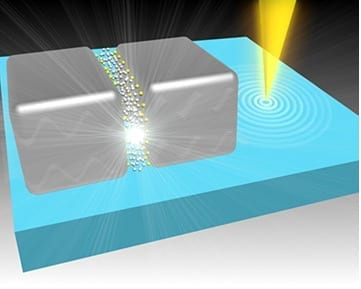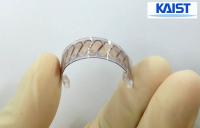
Scientific breakthrough to potentially revolutionise high-speed electronics, nanoscale opto-electronics and nonlinear optics
Assistant Professor Christian A. Nijhuis of the Department of Chemistry at the National University of Singapore’s (NUS) Faculty of Science, in collaboration with researchers from the Agency for Science, Technology and Research (A*STAR), namely Dr Bai Ping of the Institute of High Performance Computing and Dr Michel Bosman of the Institute of Materials Research and Engineering has successfully designed and fabricated electrical circuits that can operate at hundreds of terahertz frequencies, which is tens of thousands times faster than today’s state-of-the-art microprocessors.
This novel invention uses a new physical process called ‘quantum plasmonic tunnelling’. By changing the molecules in the molecular electronic device, the frequency of the circuits can be altered in hundreds of terahertz regime. The new circuits can potentially be used to construct ultra-fast computers or single molecule detectors in the future, and open up new possibilities in nano-electronic devices. The study is funded by the National Research Foundation (NRF) and A*STAR and results of the research were first published in prestigious scientific journal Science on 28 March 2014.
The quest to be super-small and super-fast
Light is used as an information carrier and transmitted in optical fibre cables. Photonic elements are large but they operate at extremely high frequencies of 100 terahertz – about 10,000 times faster than the desktop computer. But current state-of-the-art nano-electronic devices operate at length scales that are much smaller, making it very difficult to combine the ultra-fast properties of photonic elements with nano-scale electronics.
Scientists have long known that light can interact with certain metals and can be captured in the form of plasmons, which are collective, ultra-fast oscillations of electrons that can be manipulated at the nano-scale. The so-called quantum plasmon modes have been theoretically predicted to occur at atomic length scales. However, current state-of-the-art fabrication techniques can only reach length scales that are about five nanometre larger, therefore quantum-plasmon effects have been difficult to investigate.
In this landmark study, the research team demonstrated that quantum-plasmonics is possible at length scales that are useful for real applications. Researchers successfully fabricated an element of a molecular electronic circuit using two plasmonic resonators, which are structures that can capture light in the form of plasmons, bridged by a layer of molecules that is exactly one molecule thick. The layer of molecules switches on the quantum plasmonic tunneling effects, enabling the circuits to operate at terahertz frequencies.
Dr Bosman used an advanced electron microscopy technique to visualise and measure the opto-electronic properties of these structures with nanometer resolution. The measurements revealed the existence of the quantum plasmon mode and that its speed could be controlled by varying the molecular properties of the devices.
By performing quantum-corrected simulations, Dr Bai confirmed that the quantum plasmonic properties could be controlled in the molecular electronic devices at frequencies 10,000 times faster than current processors.
Explaining the significance of the findings, Asst Prof Nijhuis said, “We are very excited by the new findings. Our team is the first to observe the quantum plasmonic tunneling effects directly. This is also the first time that a research team has demonstrated theoretically and experimentally that very fast-switching at optical frequencies are indeed possible in molecular electronic devices.”
The results open up possible new design routes for plasmonic-electronics that combines nano-electronics with the fast operating speed of optics.
The Latest on: Nanoscale opto-electronics
[google_news title=”” keyword=”Nanoscale opto-electronics” num_posts=”10″ blurb_length=”0″ show_thumb=”left”]
via Google News
The Latest on: Nanoscale opto-electronics
- Applied Optoelectronics, Inc. (AAOI)on April 30, 2024 at 9:00 am
SUGAR LAND, Texas, April 29, 2024 (GLOBE NEWSWIRE) -- Applied Optoelectronics, Inc. (NASDAQ: AAOI), a leading provider of fiber-optic access network products for the internet datacenter ...
- First high-resolution 3D nanoscale chemical imaging achieved with multi-modal tomographyon April 30, 2024 at 6:21 am
By exploiting a smart learning algorithm that fuses two microscopy signals, University of Michigan researchers have accomplished high-resolution, efficient 3D chemical imaging for the first time at ...
- Applied Optoelectronics Inc AAOIon April 29, 2024 at 5:00 pm
We sell different types of products and services to both investment professionals and individual investors. These products and services are usually sold through license agreements or subscriptions ...
- Nanoscale movies shed light on one barrier to a clean energy futureon April 10, 2024 at 5:00 pm
Using nanoscale imaging techniques, Duke researchers are trying to understand why these catalysts break down and lose activity over time. Credit: Avery Vigil, Duke chemistry. Journal of the ...
- Meet the ‘quantum plumbers’ uncovering the mysteries of fluid mechanics at the nanoscaleon April 8, 2024 at 5:00 pm
Nanofluidics could be used to purify water, generate energy and build nanoscale machines. But when water flows through a carbon nanotube, classical fluid mechanics breaks down, leading to puzzling ...
- The Role of 2D Gold Flakes in Next-Gen Optoelectronicson April 8, 2024 at 7:11 am
The gold flakes’ unique properties allow the realization of plasmonic nanostructures with nanoscale optical confinement and can have potential applications in nanophotonics. 2D metals ...
- Theoretical Foundations of Nanoscale Quantum Deviceson April 2, 2024 at 6:03 pm
Nanooptics which describes the interaction of light with matter at the nanoscale, is a topic of great fundamental interest to physicists and engineers and allows the direct observation of quantum ...
- AAOI Applied Optoelectronics, Inc.on March 26, 2024 at 5:55 pm
Applied Optoelectronics, Inc. designs, manufactures, and sells fiber-optic networking products in the United States, Taiwan, and China. It offers optical modules, optical filters, lasers ...
- Quantum Effects: The Fascinating World of Nanoscale Phenomenaon March 21, 2024 at 2:50 am
Quantum dots are nanoscale semiconductor crystals that exhibit quantum ... Quantum wires and wells have found applications in high-speed electronics, optoelectronics, and quantum computing. Quantum ...
- Nanoscale Horizonson October 18, 2023 at 10:37 pm
Nanoscale Horizons Communications must include a separate ‘new concepts’ statement. This statement should be a paragraph of no more than 200 words and should address the following questions: What new ...
via Bing News










